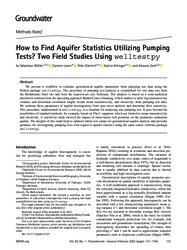How to Find Aquifer Statistics Utilizing Pumping Tests? Two Field Studies Using welltestpy
DOI: https://doi.org/10.1111/gwat.13121
Persistent URL: http://resolver.sub.uni-goettingen.de/purl?gldocs-11858/9902
Persistent URL: http://resolver.sub.uni-goettingen.de/purl?gldocs-11858/9902
Müller, Sebastian; Leven, Carsten; Dietrich, Peter; Attinger, Sabine; Zech, Alraune, 2021: How to Find Aquifer Statistics Utilizing Pumping Tests? Two Field Studies Using welltestpy. In: Groundwater, Band 60, 1: 137 - 144, DOI: 10.1111/gwat.13121.
 |
Dokument öffnen: |
We present a workflow to estimate geostatistical aquifer parameters from pumping test data using the Python package welltestpy. The procedure of pumping test analysis is exemplified for two data sets from the Horkheimer Insel site and from the Lauswiesen site, Germany. The analysis is based on a semi‐analytical drawdown solution from the upscaling approach Radial Coarse Graining, which enables to infer log‐transmissivity variance and horizontal correlation length, beside mean transmissivity, and storativity, from pumping test data. We estimate these parameters of aquifer heterogeneity from type‐curve analysis and determine their sensitivity. This procedure, implemented in welltestpy, is a template for analyzing any pumping test. It goes beyond the possibilities of standard methods, for example, based on Theis' equation, which are limited to mean transmissivity and storativity. A sensitivity study showed the impact of observation well positions on the parameter estimation quality. The insights of this study help to optimize future test setups for geostatistical aquifer analysis and provides guidance for investigating pumping tests with regard to aquifer statistics using the open‐source software package welltestpy. Article impact statement: We present a workflow to infer parameters of subsurface heterogeneity from pumping test data exemplified at two sites using welltestpy.
Statistik:
ZugriffsstatistikSammlung:
- Geologie [933]
This is an open access article under the terms of the Creative Commons Attribution License, which permits use, distribution and reproduction in any medium, provided the original work is properly cited.

